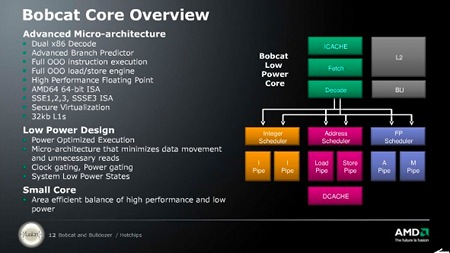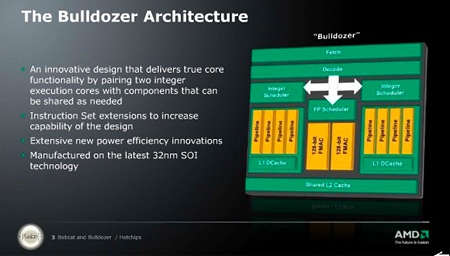AMD unveils new x86 microarchitectures
Aug 24, 2010 — by LinuxDevices Staff — from the LinuxDevices Archive — 3 viewsAdvanced Micro Devices is unveiling the technical details of two new microprocessors, “Bobcat” and “Bulldozer,” during the Hot Chips conference at Stanford University. The designs, addressing low-power netbooks and desktops on the one hand and high-performance PCs/servers on the other, are expected to begin sampling later this year.
Bobcat and Bulldozer mark the first time in nearly seven years that AMD has updated the microarchitecture of processing cores. While AMD engineers are detailing technical components of these two chips at the Hot Chips conference, the company is not expected to reveal any information about clock speed, pricing or specific release dates.

AMD's Bobcat and Bulldozer
(Click to enlarge)
However, Bobcat and Bulldozer should begin sampling to AMD's OEM partners by later this year, with sales beginning in early 2011.
AMD released the following highlights regarding Bobcat:
|
Bobcat, which AMD indicates can run with a sub-one watt thermal envelope, is clearly designed to work with portable devices and ultra-thin laptops. It's also clear that AMD is targeting Intel's Atom processor.
What will make Bobcat different from Atom is its out-of-order execution engine, which breaks data apart and allows for instructions to run in parallel, as well as offering improved performance.
Intel's Atom chips, on the other hand, use an in-order execution pipeline, which means the core will have to accept one set of instructions first before moving onto the next step.
The design also allows for clock and power gating, which allows the chip to work with portable devices while saving battery life.
From AMD's perspective, the out-of-order execution engineering combined with the low-power design will give Bobcat an advantage over Atom since it allows for high performance. AMD has also made a number of other improvements, including instruction sets that support virtualization.

AMD's Bobcat
(Click to enlarge)
However, the most important part of Bobcat is that it will be the first x86 processor core to work with AMD's APU, or accelerated processing unit, design, which looks to combine graphics and the CPU on one piece of silicon. The first of these APU chips — "Ontario" — is scheduled for a 2011 release, although AMD is not offering specifics just yet.
AMD released the following highlights regarding Bulldozer:
|
The more complicated of the new microarchitectures is Bulldozer, which promises to deliver 33 percent more cores and a 50 percent increase in throughput compared to AMD's current 12-core Opteron 6100, previously code-named Magny-Cours. Bulldozer, which is being built with 32-nanometer manufacturing, also promises better energy efficiency.
AMD has already revealed that Bulldozer supports up to 256-bit floating point execution, which is important for high-performance computing applications. However, Dina McKinney, an AMD vice president for design engineering, said the company wanted to combine two different chip technologies with Bulldozer.
While most high-performance chips use either SMT (simultaneous multithreading), which places two instructional threads on one core to allow for two tasks to execute at the same, or CMP (core multiprocessing), which essentially just increases the core count, Bulldozer combines both techniques.
By finding a third way, AMD hopes to increase performance and reduce power while keeping the chips' clock speeds at their current levels.
"Bulldozer takes SMT and CMP and combines the best of both techniques, while addressing the shortcomings of both," said McKinney. "It has dedicated execution cores, register sets, easy and predictable system performance and integration with the symmetrical cores. The two strong threads have dedicated hardware and that really bears the bulk of the workload."
A modular approach
Bulldozer is a chip design that AMD has been calling a "module." The module structure actually contains two cores, and each have their own integer scheduler units and shared floating-point scheduler. Each core has one instructional thread and dedicated L1 cache.
The module also contains two, 128-bit floating-point math units. The two cores and two floating-point units share fetch and decode units, as well as an L2 cache, L3 cache and a northbridge.

AMD's Bulldozer
(Click to enlarge)
The dedicated parts of Bulldozer — the two cores, integer schedulers and the L1 cache — handle the bulk of the workloads and can handle the most common tasks. The shared components help reduce the die size, which cuts down cost and reduced power consumption.
Each Bulldozer processor will be composed of these different modules — an eight-core processor, for example, is made up of four modules — but the modules are transparent to the hardware, applications and operating system. The OS, for instance, sees an eight-core processor and not four separate modules.
For AMD, the question is whether the company can sell a new generation of Opteron processors that use this module design, compared to the more straightforward approach Intel has with its Xeon chips.
Bulldozer and Bobcat both represent a major step for AMD as the company looks to transform itself from a traditional chip company that both designed and manufactured processors to a business that focuses solely on design. (In 2009, AMD officially spun off its manufacturing division into a new business now called Globalfoundries.)
Right now, AMD remains a distant second to Intel in the worldwide x86 processors market. However, the company has managed to stabilize its finances and its market position against a much larger competitor.
Further information
Slides and further details from the company's Hot Chips presentation about Bulldozer and Bobcat may be found here. AMD promises to provide more information on a Bulldozer blog, here.
Scott Ferguson is Managing Editor, East Coast, of our sister publication eWEEK.
This article was originally published on LinuxDevices.com and has been donated to the open source community by QuinStreet Inc. Please visit LinuxToday.com for up-to-date news and articles about Linux and open source.